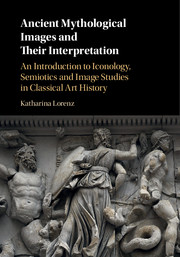 Ancient Mythological Images and their Interpretation
Ancient Mythological Images and their Interpretation 6 - Narratives of sign and signification
from SEMIOTICS
Published online by Cambridge University Press: 05 August 2016
Summary
Semiotics as experiment: the results
Semiotics invests in the understanding of cultural utterances in whatever medium, with a focus on the production of meaning from signs. Semiotics postulates that the relationship between sign and meaning is arbitrary, not natural – hence its interest in the processes within which meaning is created. This interest is put into practice by zeroing in on modes of content transmission at play in a picture, breaking the depiction down into a range of vertical and horizontal relationships and assessing their share in meaning production.
At the stage of semantic analysis, the case studies demonstrate three strengths of the semiotic approach. The first is its ability to facilitate a survey of the different media employed in a picture, alongside establishing their individual contributions to the overall content. In the case of the Karlsruhe hydria and the Great Frieze, this approach provides the toolkit for an exploration of the role of the name labels employed in the depictions and their relationship to the figural representation. The labels are a vital feature of the two depictions, since – as becomes clear from a comparison with conventional patterns of display for these two myths – not all representations of the Judgement of Paris and the gigantomachy feature such labelling.
Semiotics’ ability to differentiate between the transmission strategies of the individual media as executed here also reveals a crucial difference from the iconological approach. The latter takes a label as merely referential to the depiction, but in semiotic analysis, the relationship of depiction and label is understood to be differential. These approaches lead in turn to distinctly different results, as is particularly obvious in the case of the personification Eris on the Karlsruhe hydria (fig. 5.1): seen through the prism of iconology, the figure forms part of an iconographic change during the latter part of the fifth century and is indicative of a growing interest in the personal conditions of the individual and the causality of historical events; seen from the viewpoint of semiotics, Eris embodies the discourse around the divine and mortal played out on the vessel, sharing characteristics of both types of depicted figure.
- Type
- Chapter
- Information
- Ancient Mythological Images and their InterpretationAn Introduction to Iconology, Semiotics and Image Studies in Classical Art History, pp. 152 - 166Publisher: Cambridge University PressPrint publication year: 2016


